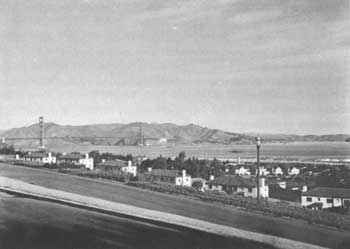





Survey of Historic Sites and Buildings
  |
PRESIDIO OF SAN FRANCISCO part of Golden Gate National Recreation Area California |
 |
| ||
The colorful history of this presidio, for almost two centuries the guardian of the finest harbor on the Pacific coast, spans the Spanish, Mexican, and American periods in California, from 1776 to the present. During all the wars and conflicts since the Mexican War—Indian, Civil, Spanish-American, World Wars I and II, Korea, and Vietnam—the post has been a major coastal defense base and, except for a 3-year period in the 1850's, command head-quarters for the Western United States and the Pacific area. It was in the latter capacity, particularly, that the presidio was involved with the Indian wars, though troops also fanned out from it to serve in the various campaigns.
The presidio's importance transcends the military and enters the realms of politics, economics, and diplomacy. Used by the Spaniards as a base for exploration and conquest, it figured prominently in their extension of settlement into northern California. The northern bastion of Spain's New World Empire, it was for many decades the chief barrier against British, Russian, and American expansion in California. Between 1821 and 1836, under Mexican rule, the presidio continued to be the military headquarters of northern California, but its strength gradually declined. In 1836, the year after the Mexican Government established Yerba Buena Pueblo (San Francisco) not far away and transferred the headquarters to Sonoma, it withdrew the garrison. The buildings disintegrated rapidly.
U.S. forces seized California in 1846. Early the following year troops garrisoned the presidio, repairing the remaining buildings and adding new ones. The next April it became a permanent post. By 1890, when it accommodated six artillery batteries, one cavalry troop, and two infantry companies, it had been permanently constructed of brick.
Two installations associated with the presidio are Fort Point (Fort Winfield Scott) and Fort Mason. The story of Fort Point traces back to the Spaniards, who established a castillo, or fort, on the site. During the years 1853-61 the U.S. Army razed the disintegrating castillo, lowered the face of the cliff on which it stood some 90 feet so that the new batteries could more easily fire on ships, and erected and immediately garrisoned the largest fortification of its kind on the Pacific coast, Fort Point.
 |
| Modern view of the Presidio of San Francisco and Golden Gate Bridge. (U.S. Army, Department of Defense) |
During the years 1865-78 Fort Point was a subpost of the presidio and for a decade after 1868 was not garrisoned. The Army redesignated it Fort Winfield Scott in 1882, and 4 years later it again became a presidio subpost. In 1897 all the guns were removed. Seriously damaged by the San Francisco earthquake of 1906 and declared unsafe, the fort was abandoned by the Army in 1914, though it received some use during World Wars I and II. The modern Fort Winfield Scott Reservation, on the western side of the presidio, includes Fort Point.
The second major installation whose history merges with that of the presidio, in Spanish times as today outside its boundaries, is Fort Mason. Originally the site of a Spanish battery, it was later a Civil War defense emplacement and the residence of prominent generals.
In addition to sites and buildings associated with the Spanish-Mexican period, various old Army buildings are extant at the presidio. The oldest remaining structure is the hospital, built in 1854. The brick stables now serve as offices and storehouses. A stone magazine dates from 1863. Fort Point is dwarfed by the Golden Gate Bridge. Changed but slightly since the time of its construction, it is one of the outstanding historical structures at the presidio and a prime example of a 19th-century coastal fort. The Fort Point Museum Association maintains a two-room museum. The modern headquarters building of Fort Winfield Scott was completed in 1912, after the old brick fort was condemned. The presidio is a registered State historical landmark.
The present 69-acre Fort Mason Reservation, under the jurisdiction of the General Services Administration and the Army, is bounded by Van Ness Avenue and Bay and Lacuna Streets. Of special interest is McDowell Hall (Brooks House No. 1), on the north side of MacArthur Avenue. A large two-story framehouse erected in 1855 and 9 years later converted into a duplex, it was the residence of 38 commanding generals of the Army's western headquarters from 1865 until 1943, including Gens. Irvin McDowell, Edward O. C. Ord, John Pope, Nelson A. Miles, and Arthur MacArthur. It is now an officers' mess.
NHL Designation: 06/13/62
 |
 |
http://www.cr.nps.gov/history/online_books/soldier-brave/sitea8.htm
Last Updated: 19-Aug-2005